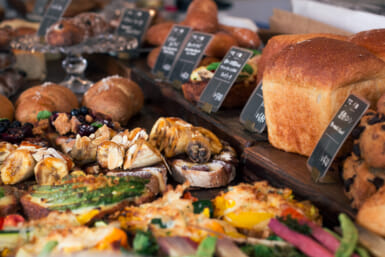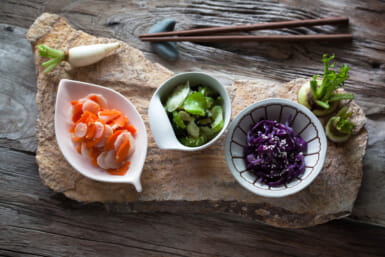with Donna Sweeny
Venetian Cuisine—Part I
THE SPICE TRADE
Although Venice may no longer possess the power and riches that it had in the 15th and 16th centuries, it remains one of the most beautiful and distinctive cities of the world— more than 100 islands connected by 400 bridges.
The contributions that this city has made to civilization have certainly been noteworthy: the Venetian School of painters which produced Titian and Tintoretto among others; Venetian architecture with its characteristic use of columns, arched windows and elaborate marble and mosaic work; Venetian glass; Venetian blinds —the list goes on and on.
While visiting there recently. I found that there was yet another most enjoyable contribution Venice has made—its unique cuisine.
Upon their return from the East in the 13th century, the Crusaders brought new spices to Europe. To say the least, they were a welcome addition to the usual diet of salted meat, dried fish and often rancid food. Pepper, cinnamon, saffron, cloves, ginger and cardomom soon became virtual treasures. Because of its location and seafaring prowess, Venice had a virtual monopoly on this new lucrative spice trade, and it became the main source of the city’s fabulous wealth.
Access to spices and an abundance of fish and seafood have enabled the Venetians to produce some wonderful combinations; the three scampi recipes which follow are good examples of this. The term “scampi” actually refers to a particular type of prawn found in the Adriatic Sea. but it has evolved into a somewhat generic term for any kind of shrimp. Shrimp can be substituted for scampi in all of these recipes.
SCAMPI—I (serves 4)
- 1 1/2 pounds scampi or shrimp, shelled and deveined
- 1/2 cup olive oil
- 3 cloves garlic, crushed
- 1/3 cup coarsely chopped fresh parsley
- Dash of cayenne pepper
- Heat the olive oil in a skillet and saute the scampi for about 4 minutes or just until they begin to turn pink.
- With a slotted spoon, remove the scampi to a heated platter.
- To the remaining olive oil in the skillet, add the garlic, parsley and cayenne pepper and cook over moderate heat about 2 minutes until the parsley is slightly wilted. Stir constantly to avoid browning the garlic.
- Pour the sauce over the scampi.
SCAMPI—II (serves 4)
- 2 tablespoons unsalted butter
- 4 cups chopped onion
- 5 cloves of garlic, crushed
- 1/2 cup chopped scallions
- 1 1/2 pounds scampi or shrimp, shelled and deveined
- 1 1/4 cups dry white wine
- 3/4 cup bread crumbs
- 1/2 teaspoon each of oregano and basil
- 1 teaspoon freshly ground black pepper
- 1 tablespoon chopped fresh parsley
- Preheat the oven to 350°F.
- Melt the butter in an ovenproof skillet and saute the onions, garlic, and scallions until the opion is translucent.
- Add the scampi and 1 cup of white wine and bring to a boil.
- Reduce heat and simmer until the scampi just start to turn pink, about 4 minutes.
- Add the bread crumbs, black pepper, oregano, basil, and parsley and 1/4 cup of white wine to the skillet.
- Bake at 350° for 10 minutes.
SCAMPI—III (serves 4)
- 2 tablespoons unsalted butter
- 3 tablespoons olive oil
- 1 1/2 pounds scampi or shrimp, shelled and deveined
- Juice of 1/2 a lemon
- 1/3 cup white wine
- 1/4 teaspoon ground saffron*
- 1 tablespoon minced fresh parsley
- In a skillet heat the butter and olive oil and saute the scampi for about 4 minutes or just until they start to turn pink.
- Remove the scampi to a serving platter and keep warm.
- Add all the remaining ingredients to the skillet and cook over medium heat, stirring constantly, for about 7 minutes until heated through and reduced by half. Spoon the sauce over the scampi.
* Saffron is most easily ground with a mortar and pestle, but putting the saffron on a flat plate and crushing it with the bowl of a teaspoon works almost as well. Rice goes well with these seafood dishes, and the fennel in the following recipe gives an unusual and refreshing taste.
FENNEL RICE (serves 4)
- 1 cup rice
- 2 fennel
- 1 large onion, chopped
- 3 tablespoons unsalted butter
- 2 cans (10 1/2 ounces each) beef broth
- 3 tablespoons freshly grated Parmesan cheese
- Scrub the fennel; remove the leaves and cut the bulb of the fennel into thin slices.
- Melt the butter in a skillet and fry the onion and fennel for 5 minutes, stirring occasionally.
- Add the rice to the skillet and fry it for an additional 5 minutes, stirring constantly.
- Slowly stir in the beef broth. Cover and simmer for 20 minutes or until the rice is done. The rice should be very moist.
- Add the Parmesan cheese to the cooked rice, stir it, and serve.
No piece on Venetian cooking would be complete without a recipe for ris e bis, a mixture of rice and peas. Traditionally served to celebrate the feast day of St. Mark, it has been popular for centuries and was supposedly a great favorite of Ernest Hemingway — it will most likely become a favorite of yours, too.
RIS E BIS (Rice and Peas) (serves 4)
- 5 slices prosciutto ham
- 3 tablespoons unsalted butler
- 1 large onion, chopped
- 1 cup rice
- 1 cup water
- 1 can (10 3/4 ounces) condensed chicken broth
- 1 cup frozen green peas
- 4 lettuce leaves, sliced in thin strips
- 3 tablespoons freshly grated Parmesan cheese
- Trim off, and discard, the excess fat from the prosciutto ham: set the ham aside.
- Melt the butter in saucepan over low heat. Stir in the prosciutto ham, chopped onion, and rice and cook until the onion is translucent.
- Add the water and chicken broth and bring to a boil. Lower the heat, cover, and simmer for 15 minutes.
- Stir in the green peas and lettuce leaves and simmer for 10 more minutes or until the rice is done.
- Sprinkle with Parmesan cheese, toss gently, and serve.
The variety of Venetian cuisine easily warrants more than one column; accordingly, we will “table talk” about this wonderful city again next time.









